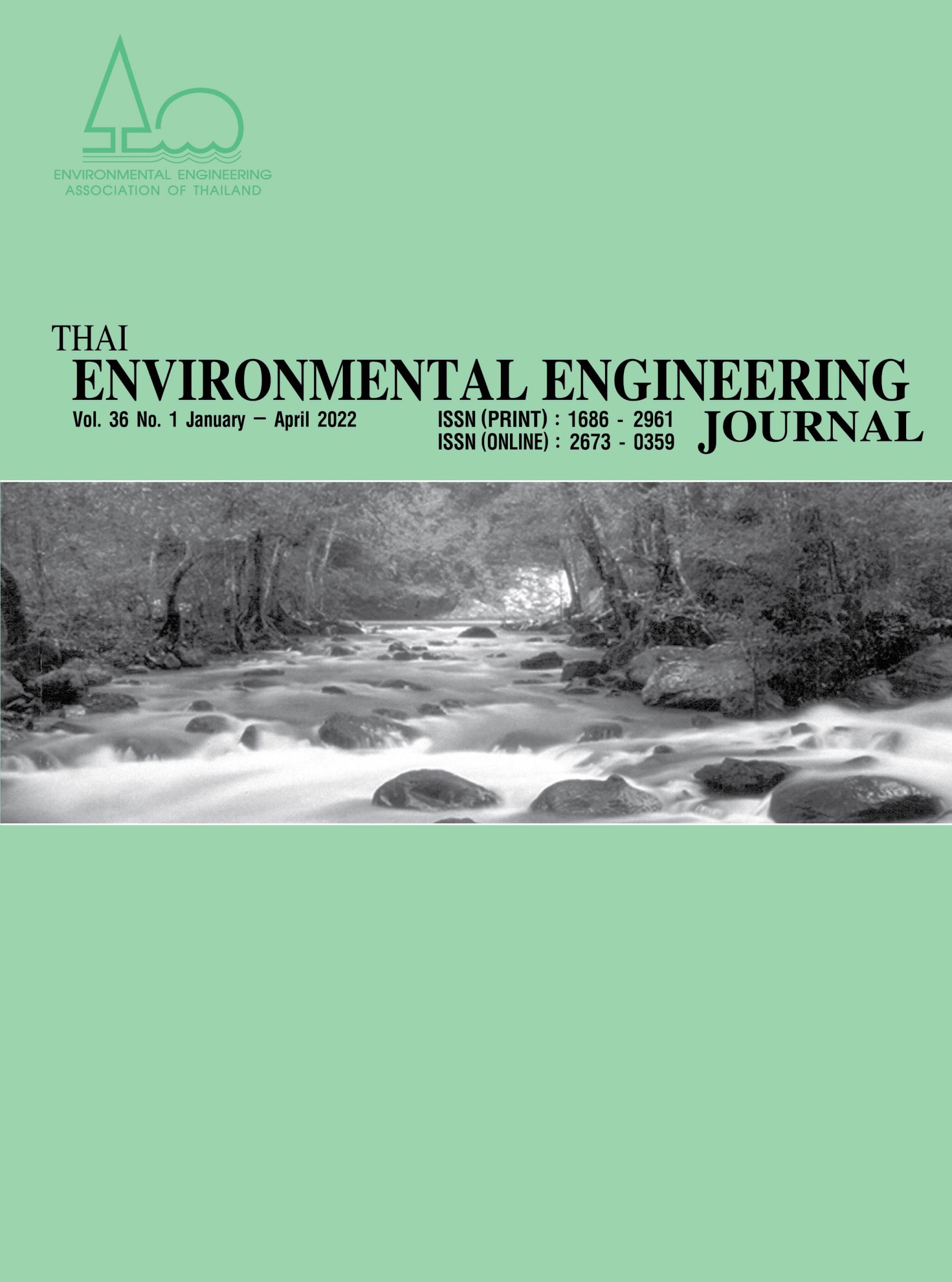A Bench Scale Study on Polluted Canal Water Purification in Comparison between with and without Addition of Fermented Products
Main Article Content
Abstract
This study aimed to investigate the possibility of using five types of fermented product (FP) to improve the removal efficiency of basic pollutants (under aerobic condition via strong agitation), i.e., non-filtered CODT, BODT and SS presenting in two polluted canals in Bangkok area, namely, San Saeb and Kaja canals. The results were compared with the ‘Control’ experiment, which was without the addition of any fermented products (FPs). Obviously, it was found that the addition of FPs (containing high VFA) increased the CODT concentration of the raw polluted water from 52 to the range of 87 – 107 mg/L. However, there was no clear-cut conclusion on the benefit of the FP addition in this study. Also, it was apparent that all five designated FPs gave similar treatment results. The only advantage of the FP supplement was to increase the MLSS or bacteria mass in less time, which is good for a startup process. However, bacterial mass (MLSS) can be enhanced through an ordinary startup without necessity of FP addition if there is no any particular problem. In conclusion, BOD and COD removals in the reactors with FP addition were not significantly different from the ‘Controls’, which eventually determined that EM and FPs addition cannot effectively treat polluted water.
Article Details
References
Higa, T. and Chinen, N. 1998. EM treatments of odor, waste water, and environment problems. Available at: http://www.scienzaegoverno.org/sites/default/files/file_attach/007_04EM.pdf. accessed on January 2017.
Panswad, T. and Pantumsinchai, P. 2006. How effective are effective microorganisms (EM)?. EEAT Yearbook and Directory 2006, 43-44.
EMRO JAPAN. 2020. EM Book 1. Available at: https://www.emrojapan.com/docs/download/EMBOOK01_English_s.pdf.
EMRO JAPAN. 2021. EM Book 2. Available at: https://www.emrojapan.com/docs/download/EMBOOK02_English_s.pdf.
EMRO. Soil Treatment with EM Compost. Available at: https://emrojapan.com/docs/download/leaflet01-soil.pdf. accessed on March 2022.
EMRO. EM BOKASHI. Available at: https://www.emrojapan.com/docs/download/leaflet02-bokashi.pdf. accessed on March 2022.
EMRO. EM Fermented Food Waste Compost (EM Compost). Available at: https://www.emrojapan.com/docs/download/leaflet03-compost.pdf. accessed on March 2022.
EMRO. EM Mud Ball. Available at: https://www.emrojapan.com/docs/download/leaflet04-mudball.pdf. accessed on March 2022.
EMRO. How to make Liquid EM Waste Oil Soap (EM Liquid Soap). Available at: https://www.emrojapan.com/docs/download/leaflet05-liquid.pdf. accessed on March 2022.
Sitarek, M., Napiórkowska-Krzebietke, A., Mazur, R., Czarnecki, B., Pyka, J.P., Stawecki, K., Olech, M., Sołtysiak, S. and Kapusta, A. 2017. Application of effective microorganisms technology as a lake restoration tool – a case study of Muchawka Reservoir. Journal of Elementology. 22(2): 529-543. DOI:10.5601/jelem.2016.21.2.1196.
Zakaria, Z., Gairola, S. and Shariff, N.M. 2010. Effective Microorganisms (EM) Technology for Water Quality Restoration and Potential for Sustainable Water Resources and Management. The 5th International Congress on Environmental Modelling and Software. Ottawa, Ontario, Canada, 142.
Namsivayam, S.K.R., Narendrakumar, G., and Kumar, J.A. 2011. Evaluation of Effective Microorganism (EM) for treatment of domestic sewage. Journal of Experimental Sciences. 2(7): 30-32.
Rois Anwar, N. Z., Abu Hassan, M. A., Mahmood, I. and Khamis, A. K. 2013. Treatment of Rubber Processing Wastewater by Effective Microorganisms Using Anaerobic Sequencing Batch Reactor. Journal of Agrobiotechnology. 4: 1-15.
Shalaby E. A. 2011. Prospects of effective microorganisms technology in wastes treatment in Egypt. Asian Pacific Journal of Tropical Biomedicine. 1(3): 243-248. https://doi.org/10.1016/S2221-1691(11)60035-X.
Okuda, A., and Higa, T. 1999. Purification of waste water with Effective Microorganisms and its utilization in agriculture. Paper presented at the The 5th International Conference on Kyusei Nature Farming, Thailand, 1998, Thailand.
Wood, M., Higa, T., Farrelly, P., and Simpson, B. 2004. EM Projects in USA. Available at: http://www.futuretechtoday.com/em/NZOralPresen.pdf. accessed on October 2016.
Panswad, D. and Chinwetkitvanich, S. 2017. Bacterial growth patterns and COD reduction in agitated vessels treating sterilized vs non-sterilized polluted canal water, with and without fermented products addition. Oral presentation in The 6th International Conference on Environmental Engineering, Science and Management, May 17-18, 2017, Bangkok, Thailand.
Kaewruang, S., Panswad, D. and Chinwetkitvanich, S. 2013. Potential and reality of bio-fermented solution on treating polluted water. Oral presentation in The International Conference Environmental and Hazardous Substance Management towards a Green Economy (EHSM 2013) May 21-23, 2013, Bangkok, Thailand.
APHA, A. and WEF. 2005. Standard methods for the examination of water and wastewater (21 ed.). Washington. DC: American Public Health Association.
Satyawali, Y. and Balakrishnan, M. 2008. Wastewater treatment in molasses-based alcohol distilleries for COD and color removal: a review. Journal of Environmental Management. 86(3): 481-497.
Cóndor_Golec, A.F., Pérez, P.G. and Lokare, C. 2007. Effective Microorganisms: Myth or reality?. Revista Peruana De Biología. 14(2): 315-319. https://doi.org/10.15381/rpb.v14i2.1837.
Monica, S., Karthick, L., Mythili, S. and Sathiavelu, A. 2011. Formulation of effective microbial consortia and its application for sewage treatment. Microbial & Biochemical Technology. 3(3): 51-55.
Sakarika, M., Spanoghe, J., Sui, Y.X., Wambacq, E., Grunert, O., Haesaert, G., Spiller, M. and Vlaeminck, S.E. 2020. Purple non-sulphur bacteria and plant production: benefits for fertilization, stress resistance and the environment. Microbial Biotechnology. 13(5): 1336-1365.


